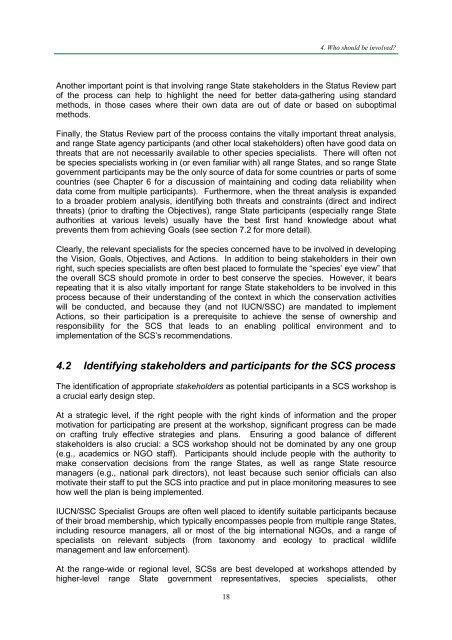Strategic Planning for Species Conservation: A Handbook - IUCN
Strategic Planning for Species Conservation: A Handbook - IUCN
Strategic Planning for Species Conservation: A Handbook - IUCN
Create successful ePaper yourself
Turn your PDF publications into a flip-book with our unique Google optimized e-Paper software.
18<br />
4. Who should be involved?<br />
Another important point is that involving range State stakeholders in the Status Review part<br />
of the process can help to highlight the need <strong>for</strong> better data-gathering using standard<br />
methods, in those cases where their own data are out of date or based on suboptimal<br />
methods.<br />
Finally, the Status Review part of the process contains the vitally important threat analysis,<br />
and range State agency participants (and other local stakeholders) often have good data on<br />
threats that are not necessarily available to other species specialists. There will often not<br />
be species specialists working in (or even familiar with) all range States, and so range State<br />
government participants may be the only source of data <strong>for</strong> some countries or parts of some<br />
countries (see Chapter 6 <strong>for</strong> a discussion of maintaining and coding data reliability when<br />
data come from multiple participants). Furthermore, when the threat analysis is expanded<br />
to a broader problem analysis, identifying both threats and constraints (direct and indirect<br />
threats) (prior to drafting the Objectives), range State participants (especially range State<br />
authorities at various levels) usually have the best first hand knowledge about what<br />
prevents them from achieving Goals (see section 7.2 <strong>for</strong> more detail).<br />
Clearly, the relevant specialists <strong>for</strong> the species concerned have to be involved in developing<br />
the Vision, Goals, Objectives, and Actions. In addition to being stakeholders in their own<br />
right, such species specialists are often best placed to <strong>for</strong>mulate the “species’ eye view” that<br />
the overall SCS should promote in order to best conserve the species. However, it bears<br />
repeating that it is also vitally important <strong>for</strong> range State stakeholders to be involved in this<br />
process because of their understanding of the context in which the conservation activities<br />
will be conducted, and because they (and not <strong>IUCN</strong>/SSC) are mandated to implement<br />
Actions, so their participation is a prerequisite to achieve the sense of ownership and<br />
responsibility <strong>for</strong> the SCS that leads to an enabling political environment and to<br />
implementation of the SCS’s recommendations.<br />
4.2 Identifying stakeholders and participants <strong>for</strong> the SCS process<br />
The identification of appropriate stakeholders as potential participants in a SCS workshop is<br />
a crucial early design step.<br />
At a strategic level, if the right people with the right kinds of in<strong>for</strong>mation and the proper<br />
motivation <strong>for</strong> participating are present at the workshop, significant progress can be made<br />
on crafting truly effective strategies and plans. Ensuring a good balance of different<br />
stakeholders is also crucial: a SCS workshop should not be dominated by any one group<br />
(e.g., academics or NGO staff). Participants should include people with the authority to<br />
make conservation decisions from the range States, as well as range State resource<br />
managers (e.g., national park directors), not least because such senior officials can also<br />
motivate their staff to put the SCS into practice and put in place monitoring measures to see<br />
how well the plan is being implemented.<br />
<strong>IUCN</strong>/SSC Specialist Groups are often well placed to identify suitable participants because<br />
of their broad membership, which typically encompasses people from multiple range States,<br />
including resource managers, all or most of the big international NGOs, and a range of<br />
specialists on relevant subjects (from taxonomy and ecology to practical wildlife<br />
management and law en<strong>for</strong>cement).<br />
At the range-wide or regional level, SCSs are best developed at workshops attended by<br />
higher-level range State government representatives, species specialists, other

















